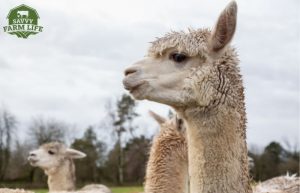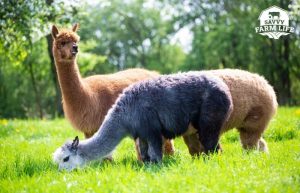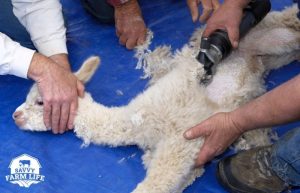
What You Need to Know About Caring For Alpacas
All livestock require care and attention, and alpacas are no exception. Of course, some livestock are higher maintenance than others, and when considering adding alpacas to your homestead you may be wondering how difficult alpacas are to care for. How do alpacas rate when it comes to care and maintenance?
Are alpacas hards to care for? While the luxurious and elegant look of the alpaca may lead you to believe they are difficult to maintain, the truth is that alpacas are generally low-maintenance and easy to care for when compared to other livestock. They do well in most climates, they require little feed compared to animals of similar size, and they can be easily trained to accept handling.
Continue reading to learn more about alpacas and how to meet their specific needs!
What Are Alpacas?
Alpacas are in the Camelid family. As the name implies, this family includes camels, and also llamas and alpacas. While camels carry the distinctive humps, llamas and alpacas are often confused for one another. One obvious difference between the two is that llamas are about twice the size of alpacas, with alpacas averaging around 120 to 200 pounds.
Alpacas are called pseudo-ruminants, with one stomach divided into three compartments (true ruminants, such as the cow and sheep, have four compartments instead of three). This makes them efficient eaters, able to turn a smaller amount of food into the energy that they need.
Alpacas have been domesticated for thousands of years, and are as popular a livestock choice for homesteaders today as they were in the past. Part of this popularity is due to their gentle and elegant nature, and the relatively simple care that they require.
What Is Involved In Caring for Alpacas?
Like any livestock or pet, alpacas will have specific needs that must be met. This includes shelter and environmental needs, feeding requirements, and regular health maintenance.
Caring For Alpacas: Shelter and Confinement
Alpacas are able to thrive in almost all climate conditions – from very cold Winters, to hot and humid Summers. However, as with any animal, they will require protection from the elements during extreme weather. The type of shelter your alpaca will need will depend greatly on your region. Most alpacas will be happy with a simple 3-sided shelter or run-in, where they can escape the cold wind or hot sun as they feel the need.
If you live in an extremely cold climate, however, you may consider having an insulated barn for them to spend the nights. If you live in a hot climate and are expecting a particularly brutal heat wave, you may consider adding fans to the shelter. During a heat wave, you can also spray water on the alpaca’s belly, which is where their heat will dissipate. Taking these extra precautions during extreme weather are no different than the additional steps that would need to be taken for any livestock or pet that lives primarily outdoors.
Alpaca Fencing
Alpacas are gentle, calm animals and do not generally challenge fencing. However, because of their size and vulnerability, you should choose your fencing according to the predators that you have in your region. A good standard to put into place is the 5’ 2”x4” no-climb fencing; this will be effective against most predators. Another option is to add barbed wire or electric fencing to both the bottom and top of your fencing to discourage predators from digging under the fence or jumping over the fence.
You may also consider a livestock guardian dog (LGD) such as a Great Pyrenees or an Anatolian Shepherd. A llama or donkey may also be used as an effective guardian for a herd of alpacas. To learn more about livestock guardians, check out my article What Are the Best Livestock Guardian Animals?
One additional note about fencing – if you have a pond or a creek, you may want to fence it off so that the alpacas cannot access it. They will enjoy using the water to cool off, which can increase the spread of parasites and negatively affect their fleece.
Cleaning Up After Your Alpaca
I have never heard anyone say that their favorite farm chore is picking up poop. No one enjoys coop-cleaning or manure-shoveling. One of the many pleasant points about alpacas is that they are surprisingly easy to clean up after. Alpacas eliminate waste in communal piles – usually having three to four piles throughout their pasture or pen. Wouldn’t it be great if all livestock and pets used the same toilet area time after time? Alpacas will usually use these same areas to eliminate each time they need to go. Instead of making 25 stops with the wheelbarrow as you will in a horse pasture, you will only need to make a handful of stops, making it an easier process to manage.
Not only is the poop easier to pick up because they tend to go in the same area each time, but the manure itself is also easy to handle – it is small, dry, and relatively odorless. Because of these attributes, alpaca manure does not attract nearly the amount of flies that other livestock manure attracts (win win!). An added bonus is that it is not particularly high in nitrogen, which means that you can add it straight to the garden without first composting. If you are one who likes to use manure as fertilizer, this is a big upside. Turning compost piles is an additional step that is not required for alpacas.
Caring For Alpacas: Diet and Nutrients
 Alpacas are very efficient eaters, able to meet their nutritional needs on a relatively small amount of food. Specifically, it is recommended alpacas eat 1.5% to 2% of their body weight in hay or pasture. For a 150 pound alpaca, this will come out to between 2.25 and 3 pounds of hay or pasture per day.
Alpacas are very efficient eaters, able to meet their nutritional needs on a relatively small amount of food. Specifically, it is recommended alpacas eat 1.5% to 2% of their body weight in hay or pasture. For a 150 pound alpaca, this will come out to between 2.25 and 3 pounds of hay or pasture per day.
Because alpacas are efficient eaters and are easier on the pasture than other livestock, you can keep up to ten alpacas on one acre of land (provided the pasture is irrigated and healthy). Alpacas have pads instead of hooves, which is less disruptive to the land. In addition to this, they have only bottom front teeth, and just a top front pad, so they do not rip out the roots of the grass like a horse does, but rather clip the tops of the grass.
What to Feed Alpacas
What if your pasture is not sufficient to meet the daily nutritional needs of your alpacas? Many are not, and in this situation you will feed them hay. Because alpacas are grazing animals, it is best to provide the hay in a slow feeder so that they will ideally have access to the hay throughout the day. Avoid using hay nets, however, in order to prevent the alpaca from reaching his head into the net and getting stuck or even strangled by the net.
The best hay to feed your alpaca will be grass hay such as Orchard Grass, Timothy, or Bermuda (though Bermuda is slightly lower in protein content than Orchard Grass and Timothy). You will want to avoid Alfalfa and Clover, or at least limit the amount they are given, because of the rich, high protein content. Feeding hay that is too rich will cause stomach problems for the alpaca.
Alpaca Pellets and Supplements
In addition to hay and pasture, you may choose to supplement your alpaca’s diet with either pellets or dietary supplements. Grain is an excellent way to provide your alpaca with additional calories if needed, but should be fed sparingly to healthy alpacas. Most alpacas will get everything they need through their hay and / or pasture, and may tend to overeat if given the opportunity.
Alpacas with heavy fleece, especially those born in the Fall, may also require a Vitamin D supplement to promote proper growth.
Some alpacas, particularly dams who are pregnant or lactating, may also benefit from additional nutritional supplements. Please consult your vet when deciding on a feeding plan for your alpacas, as the needs may vary depending on the health, age, and condition of each individual alpaca.
Alpaca Water Needs
Alpacas drink a lot of water – up to 5 gallons per day, and more on hot Summer days. Alpacas can be picky about their water, and will not drink it if it looks dirty. A good rule of thumb is to consider whether you would drink the water – if you would not, then neither will your alpaca. For this reason, it is important to check and change your alpaca’s water at least twice per day. An alternative to this is to install automatic waterers, providing clean water on demand.
Caring For Alpacas: Health Maintenance
Alpacas need regular health maintenance, as does every domesticated animal. There are a few different aspects to keeping alpacas healthy – including nail trimming, shearing, vaccines, and worming.
Shearing Alpacas
Part of the appeal of alpacas is their beautiful, luxurious fleece. It is prized for its softness, its durability, and its protection against both the cold and the wet weather. It is also profitable, providing an average of five to ten pounds of fleece per year, and the reason many farmers choose to raise alpacas.
As with the wool of a sheep, alpaca fleece will continue to grow if not shorn, which will become hazardous and extremely uncomfortable to a neglected alpaca. Alpacas must be shorn at least annually for this reason. Most who raise alpacas choose to shear them after the Winter cold has passed, and it is imperative to shear them before the Summer if you live in a hot climate. This will help to keep the alpaca cool during the hot Summer months.
One note about Spring shearing – make sure that you leave at least two centimeters of fleece on the animal, to prevent sunburns.
Can You Shear Your Alpaca Yourself?
 You can shear your alpaca yourself, and like all skills, it will become easier with practice. Shearing will be much easier and less stressful for you (and the animal) if you have trained your alpaca to be comfortable with you and accept a halter. This doesn’t mean that you cannot train an older alpaca to be comfortable being shorn by you – it will just take patience and some practice (and treats never hurt!).
You can shear your alpaca yourself, and like all skills, it will become easier with practice. Shearing will be much easier and less stressful for you (and the animal) if you have trained your alpaca to be comfortable with you and accept a halter. This doesn’t mean that you cannot train an older alpaca to be comfortable being shorn by you – it will just take patience and some practice (and treats never hurt!).
In any event, shearing is stressful for most alpacas (and sheep, and any animal that must be shorn), but there are steps you can take to make it less stressful. Spend a little time training your alpaca to accept a halter, and this will make it easier to catch them and tie them for shearing. Alpacas can also be shorn while laying down, but research has shown that alpacas shorn in this position have a higher heart rate and cortisol count than those shorn in an upright position. If you are able, halter your alpaca and tie him or her so that they can be shorn upright.
If you must shear your alpaca while he is laying down, it usually works well to gently push the animal so that they are laying on their sides. Alpacas “cush” while they lay down, which means that they lay down in an upright position with their legs folded under them. While it is possible to shear part of your alpaca’s fleece in this position, you will need them on their sides to shear it all. Regardless of the position in which you choose to shear, remember to remain calm and deliberate, and if you are patient, your practice will pay off.
Trimming Alpaca Toenails
Unlike goats and horses with their hooves, alpacas have two toes, each with soft pads and hard toenails attached. Alpaca toenails need to be trimmed regularly to keep them comfortable. How often you will need to trim your alpaca’s toenails will depend on the ground that they walk on during the day. The harder the ground, the less often you will need to trim your alpaca’s nails. With that said, alpacas need to have their toenails trimmed every two to four months on average, with darker nails needing fewer trimmings than lighter and white toenails which tend to grow more quickly.
Like shearing, you can certainly trim your alpaca’s toenails yourself. Again, this is much easier if your alpaca is halter-trained. Once you put the halter on, you will tie your alpaca and lift each foot one at a time. Alpacas who are not accustomed to lifting their feet for you may find it more comfortable if you use your own knee to support the leg that you are lifting. This will help them to feel balanced and secure.
You will need proper alpaca nail trimmers, and should cut into the nails perpendicularly so that the quick is not compressed and does not cause pain and unnecessary stress to the animal. It will be easier on your alpaca if you are able to halter and tie the animal, trimming the nails while your alpaca is upright. However, you can also trim an alpaca’s toenails while they are laying down – gently pushing them to the side if they are cushing so that you have clear access to each toenail. As with shearing, the more practice you get, and the calmer your demeanor, the easier this will be on both you and your alpaca.
Alpaca Vaccines
It is recommended that alpacas receive regular vaccinations, including annual rabies boosters, annual type C and D boosters (effective against bacterial infections), and annual tetanus vaccinations. You can have a vet vaccinate your alpaca, or you can purchase the vaccines online or from your local feed store and administer them yourself. Other vaccinations may be recommended depending on your environment and region – for example, liver fluke and meningeal worm vaccinations may be encouraged if these are prevalent in your area.
De-worming Your Alpaca
While alpacas are typically healthy animals, they are susceptible to several different parasites, including coccidia, liver fluke, and tapeworms. It is also recommended that you deworm your alpaca on a regular basis – most recommend at least every three months, however you should take into account the region you are in. Some may only administer worming medication during the months when parasites are most active. As with vaccinations, you can find these medications yourself online or at your local feed store, and can administer them on your own.
There are a few additional steps you can take to prevent parasitic infections. Because sheep and goats share parasites with alpacas, you should be cautious when keeping them in a co-existing herd. (To learn more about keeping alpacas with sheep, visit my article Can Alpacas Be Kept With Sheep?) Alpacas can, and should, graze with horses however – horses can consume the parasites that can be a problem for your alpaca. Other steps to take are to provide clean water, not allow grazing in previously flooded areas, and provide hay in a rack instead of on the ground.
Alpacas Are Relatively Easy to Care For
As with any animal that you are responsible for, alpacas will need regular care and maintenance. However, when taking into account the care needs of most other livestock and pets, you will see that alpacas are actually very easy to care for! They tend to take care of themselves, they are clean animals, and they are usually healthy and hardy. The ease of their care is just one reason that alpacas might make a great addition to your homestead.
Are you planning to invest in small livestock, but don’t know where to start? Check out these articles that overview the care of small livestock and poultry:
